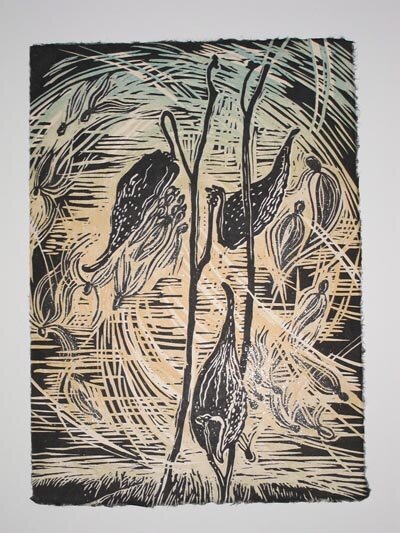Woodcut and Relief Prints
Woodcut
Usually done on plank grain wood, using open gouges, knives and chisels to carve away the non-image areas. Woods like birch, basswood, Japanese shina (in the Linden family), and some hard woods such as cherry and pear are the most common. Plywood is often used, especially for blocks requiring wider sizes. The resulting image is often bold and graphic, sometimes emphasizing the wood grain. It can be developed as a black-line cut or a white-line cut, or any combination. In the 15th Century Albrecht Durer mastered the woodcut, producing highly detailed and tonal images using primarily black-line cutting.
Color Relief Prints
Multi-block – in this technique each color in the image requires a separate block with only the areas carrying that color standing, and the rest of the block is carved away. Often a Key block with black-line contours or other descriptive information is made first and transferred to “back-up” blocks that carry the individual colors. The Key block is usually printed last in a dark color to tie the composition together. Japanese Moku hanga and Ukiyo-e color woodcuts are primarily made with this technique.
Reduction
Traditionally this color printing technique uses a single block. Any pure whites in the image are cut away and the entire edition is printed with the lightest color (i.e. yellow). The areas where that yellow is meant to appear in the final print are carved away from the block so that when the next darkest color is rolled on the block and printed the yellow shows through the holes. This process is repeated, working from light to dark, with each layer printed in perfect register until the print is resolved. In order to help localize colors, stencils can be used when rolling up the block. Picasso worked with the reduction technique in the 1960’s in France using linoleum for a series of very important prints.
Letterpress
First developed in China, printing from movable type was later developed as a commercial process in Europe during the middle of the 15th Century. Printing from lead and wood type, this printing process survived well into the middle of the 20th as a commercial printing process, gradually being replaced by offset lithography. It has had a resurgence in recent years as a craft technique suited to finely printed artists’ books and single sheet broadsides/posters.




